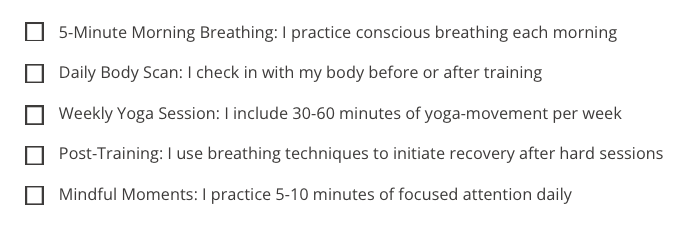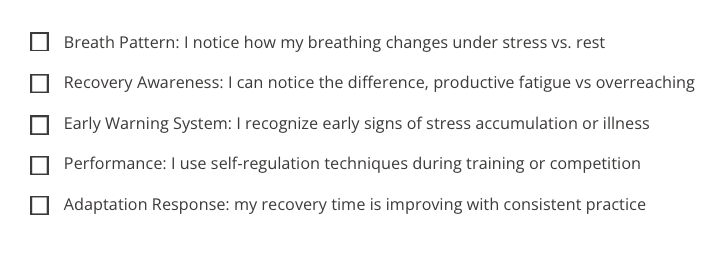Empowering Athletes Through Yoga: A Framework for Self-Regulation
Elite athletes operate in a constant state of high demand. Training sessions tax physiological systems, competitions challenge psychological resilience, and the pressure to perform tests emotional boundaries daily. In this demanding environment, the ability to self-regulate, to recognize internal signals and respond appropriately, becomes a performance advantage.
Yoga offers athletes more than flexibility and recovery. It provides a practical framework for developing heightened self-awareness and self-regulation skills that translate directly to sport performance.
What Is Self-Regulation in Athletic Performance?
Self-regulation is the capacity to monitor and control your physiological, psychological, and emotional states. For athletes, this means:
Recognizing early signs of fatigue or overtraining
Managing pre-competition anxiety
Controlling arousal levels during critical moments
Accelerating recovery between training sessions
Making real-time adjustments to breathing, heart rate, and muscle tension
Through movement, controlled breathing, and focused concentration, practicing yoga may help athletes learn to control physiological parameters such as respiratory rate, heart rate, blood pressure, skin resistance, body temperature, brain waves, and metabolic rate (Herrick & Ainsworth, 2000).
The Three Pillars: Breath, Movement, and Mindfulness
1. Breath: Your Direct Line to the Nervous System
Breathing is both automatic and controllable, making it a powerful entry point for self-regulation. Through breath control practice, athletes can override stimuli to the respiratory centers and directly influence autonomic nervous system function.
The Science:
Slow, controlled breathing augments baroreflex sensitivity and heart rate variability by re-synchronizing the inherent rhythms of the heart. This downregulates respiration rate, blood pressure, and activates the parasympathetic nervous system, the body's recovery mode (Jayasinghe, 2004).
Studies demonstrate that just six weeks of yoga breathing can significantly increase forced vital capacity (FVC), forced expiratory volume (FEV1), peak expiratory flow rate (PEFR), and maximum voluntary ventilation (MVV) while reducing breathing frequency in healthy participants (Raub, 2002; Trakroo & Bhavanani, 2016).
Practical Application:
Begin with simple awareness: Notice your natural breathing pattern before, during, and after training
Practice controlled breathing techniques to increase ribcage mobility and respiratory muscle strength
Use slow, deep breathing post-competition to accelerate recovery and shift the body back toward homeostasis
2. Movement: Building Body-Mind Awareness
Yoga moves through all planes of movement, frontal, sagittal, and transverse, activating smaller stabilizer muscles often neglected in sport-specific training. This comprehensive approach develops proprioception and spatial awareness (Goel, 2015).
The Science:
Connecting breath and movement brings athletes back to the present moment and increases connection to current physiological sensations, facilitating body-mind awareness (Van der Kolk, 2006). This enhanced awareness can lead to improved recovery, enhanced balance, decreased injury, improved biomechanics, and increased breathing function.
In college athletes, just ten weeks of yoga practice (twice weekly, 60 minutes per session) resulted in significant gains in flexibility and balance (Polsgrove, Eggleston, & Lockyer, 2016). For Italian short track speed skaters, an eight-week yoga program improved postural functionality and on-ice body awareness, with specific efficiencies gained in separating upper body from hips, thus improving skating technique (Brunelle et al., 2015).
Practical Application:
Start with fundamental poses that emphasize alignment and stability
Progress to movements that challenge balance and coordination
Pay attention to asymmetries and compensations that may indicate overuse or imbalance
Use modified poses to address sport-specific needs and limitations
3. Mindfulness: Training Attention and Awareness
Mindfulness practice involves attention to internal and external stimuli with nonjudgmental present moment awareness. For athletes, this translates to better focus, emotional regulation, and stress management.
The Science:
Regular mindfulness practice through yoga leads to measurable brain changes, including thickened prefrontal cortex and enhanced right anterior insula, regions associated with attention, interoception, and sensory processing (Van der Kolk, 2006). Twelve-week yoga interventions have shown significant improvements in mood, decreased anxiety, and increased thalamic GABA levels compared to metabolically matched controls (Streeter et al., 2010).
In NCAA Division I athletes, five weeks of mindfulness training followed by daily yoga significantly increased mindfulness and goal-directed energy compared to controls (Goodman, Kashdan, Mallard, & Schumann, 2014).
Practical Application:
During yoga practice, notice when the mind wanders and gently return attention to breath and sensation
Observe physical discomfort without immediately reacting or adjusting
Transfer this awareness to training: notice fatigue signals, tension patterns, and mental state
Use mindful check-ins throughout the day to assess recovery status
Practical Self-Regulation Strategies
Morning Assessment Protocol
Before getting out of bed, notice your breathing pattern
Perform a mental body scan from head to toe
Rate your energy, mood, and muscle soreness (1-10 scale)
Consider adjusting your day's training based on these signals
Post-Training Recovery
Transition into slow, deep breathing (4-6 breaths per minute)
Move through gentle stretches with attention to areas of tension
End with 5 minutes of mindful rest to consolidate recovery signals
Pre-Competition Routine
Use energizing breath techniques to increase alertness
Perform dynamic movement sequences to prepare the body
Focus attention on controllable factors and process goals
Use 2-3 minutes of breath work to optimize arousal level
Safety Considerations
While yoga is generally as safe or safer than other forms of exercise (Cramer et al., 2015), injury can occur. Athletes should be aware that:
The most common injuries occur in tendons, muscle-tendon joints, and fibrocartilages (Le Corroller et al., 2012)
Hand-, shoulder-, and head-stands, forward bends and backbends, and certain seated poses are more injury-related (Cramer et al., 2019)
Modified poses are safer than full variations (Wiese et al., 2019)
Qualified instructors with sport science understanding are essential
Any posture causing pain should be avoided
Best Practice: Work with a qualified yoga instructor who understands the demands of competitive athletics and can collaborate with your performance team.
Self-Regulation Development Checklists
Practice Checklist: Building Your Foundation
These are the fundamental practices that develop self-regulation capacity, begin with what feels most accessible and build from there.
Goal: Check 3+ boxes consistently before advancing to monitoring.
Monitoring Checklist: Tracking Your Progress
Once you have established regular practice, these markers indicate you are developing authentic self-regulation skills that translate to performance.
Progress Indicator: When you can check 4+ boxes, you are developing strong self-regulation capacity.
Reflection Prompts
Self-regulation is a way of being. When you can, take a moment to reflect:
Connection: When do I feel most connected to my body's signals, and what conditions allow that awareness?
Consequences: What patterns emerge between ignoring my body's feedback and injury, illness, or underperformance?
Recovery Recognition: What does "recovered" actually feel like in my body? Can I describe those sensations?
Awareness Spectrum: Am I reacting to my body's signals, or responding to them with intention?
Barriers: What's really preventing me from practicing self-awareness, time, perception, or discomfort with internal focus?
Ready to Develop Self-Regulation Skills?
The journey toward self-regulation through yoga begins with simple awareness. You don't need an hour-long practice or perfect poses. Begin with:
Five minutes of conscious breathing each morning
A brief body scan before and after training
One 30-minute yoga-informed recovery session per week
Curiosity about your internal experience without judgment
As you develop these skills, you will begin to notice increased sensitivity to your body's signals, the subtle shift from productive training to overreaching, the early signs of coming illness, the optimal arousal state for peak performance.
Take Action
If you're an athlete, coach, or performance professional looking to integrate yoga-informed self-regulation strategies into your program, let's work together.
Book a complementary discovery session or explore custom athlete education programs designed to bridge the gap between traditional yoga practices and sport science principles.
Note: This framework should complement, not replace, personalized strength programming, sport-specific training, and guidance from qualified coaches and sport scientists. Work with a qualified yoga instructor who understands the demands of competitive athletics when implementing these strategies.
References
Alexander, G. K., Rollins, K., Walker, D., Wong, L., & Pennings, J. (2015). Yoga for self-care and burnout prevention among nurses. Workplace Health & Safety, 63(10), 462-470.
Boyle, C. A., Sayers, S. P., Jensen, B. E., Headley, S. A., & Manos, T. M. (2004). The effects of yoga training and a single bout of yoga on delayed onset muscle soreness in the lower extremity. Journal of Strength and Conditioning Research, 18(4), 723-729.
Brunelle, J. F., Blais-Coutu, S., Gouadec, K., Bedard, E., & Fait, P. (2015). Influences of a yoga intervention on the postural skills of the Italian short track speed skating team. Open Access Journal of Sports Medicine, 6, 23.
Cramer, H., Ostermann, T., & Dobos, G. (2018). Injuries and other adverse events associated with yoga practice: A systematic review of epidemiological studies. Journal of Science and Medicine in Sport, 21(2), 147-154.
Cramer, H., Quinker, D., Schumann, D., Wardle, J., Dobos, G., & Lauche, R. (2019). Adverse effects of yoga: a national cross-sectional survey. BMC Complementary and Alternative Medicine, 19(1), 190.
Cramer, H., Ward, L., Saper, R., Fishbein, D., Dobos, G., & Lauche, R. (2015). The safety of yoga: a systematic review and meta-analysis of randomized controlled trials. American Journal of Epidemiology, 182(4), 281-293.
Goel, M. (2015). Yoga-A Way of Life and Its Importance in Sports. International Journal of Recent Research Aspects, 2(1), 171-172.
Goodman, F. R., Kashdan, T. B., Mallard, T. T., & Schumann, M. (2014). A brief mindfulness and yoga intervention with an entire NCAA Division I athletic team: An initial investigation. Psychology of Consciousness: Theory, Research, and Practice, 1(4), 339.
Herrick, C. M., & Ainsworth, A. D. (2000). Invest in yourself: Yoga as a self‐care strategy. Nursing Forum, 35(2), 32-36.
Iftekher, S. N. M., Bakhtiar, M., & Rahaman, K. S. (2017). Effects of yoga on flexibility and balance: a quasi-experimental study. Asian Journal of Medical and Biological Research, 3(2), 276-281.
Jayasinghe, S. R. (2004). Yoga in cardiac health (a review). European Journal of Cardiovascular Prevention & Rehabilitation, 11(5), 369-375.
Karimi, M., & Yazdani Noori, A. (2015). Serotonin and mood state changes in Response to a period of yoga training in well-trained Wrestlers. International Journal of Wrestling Science, 5(2), 89-92.
Kellmann, M., Bertollo, M., Bosquet, L., Brink, M., Coutts, A. J., Duffield, R., ... & Kallus, K. W. (2018). Recovery and performance in sport: consensus statement. International Journal of Sports Physiology and Performance, 13(2), 240-245.
Kenttä, G., & Hassmén, P. (1998). Overtraining and recovery. Sports Medicine, 26(1), 1-16.
Kusuma, D. W. Y., & Bin, W. (2017). Effect of yoga program on mental health: Competitive anxiety in Semarang badminton athletes. KEMAS: Jurnal Kesehatan Masyarakat, 13(1), 121-130.
Le Corroller, T., Vertinsky, A. T., Hargunani, R., Khashoggi, K., Munk, P. L., & Ouellette, H. A. (2012). Musculoskeletal injuries related to yoga: imaging observations. American Journal of Roentgenology, 199(2), 413-418.
Ortiz Jr, R. O., Elder, A. J. S., Elder, C. L., & Dawes, J. J. (2019). A systematic review on the effectiveness of active recovery interventions on athletic performance of professional-, collegiate-, and competitive-level adult athletes. The Journal of Strength & Conditioning Research, 33(8), 2275-2287.
Patil, S. G., Mullur, L. M., Khodnapur, J. P., Dhanakshirur, G. B., & Aithala, M. R. (2013). Effect of yoga on short-term heart rate variability measure as a stress index in subjunior cyclists: a pilot study. Indian Journal of Physiology and Pharmacology, 57(2), 153-8.
Polsgrove, M. J., Eggleston, B. M., & Lockyer, R. J. (2016). Impact of 10-weeks of yoga practice on flexibility and balance of college athletes. International Journal of Yoga, 9(1), 27.
Raub, J. A. (2002). Psychophysiologic effects of Hatha yoga on musculoskeletal and cardiopulmonary function: a literature review. The Journal of Alternative & Complementary Medicine, 8(6), 797-812.
Streeter, C. C., Whitfield, T. H., Owen, L., Rein, T., Karri, S. K., Yakhkind, A., ... & Jensen, J. E. (2010). Effects of yoga versus walking on mood, anxiety, and brain GABA levels: a randomized controlled MRS study. The Journal of Alternative and Complementary Medicine, 16(11), 1145-1152.
Trakroo, M., & Bhavanani, A. B. (2016). Physiological Benefits of Yogic Practices: A Brief Review. Medicine, 1(1), 0031-0043.
Van der Kolk, B. A. (2006). Clinical implications of neuroscience research in PTSD. Boston, MA. Annals New York Academy of Science.
Wiese, C., Keil, D., Rasmussen, A. S., & Olesen, R. (2019). Injury in yoga asana practice: Assessment of the risks. Journal of Bodywork and Movement Therapies, 23



